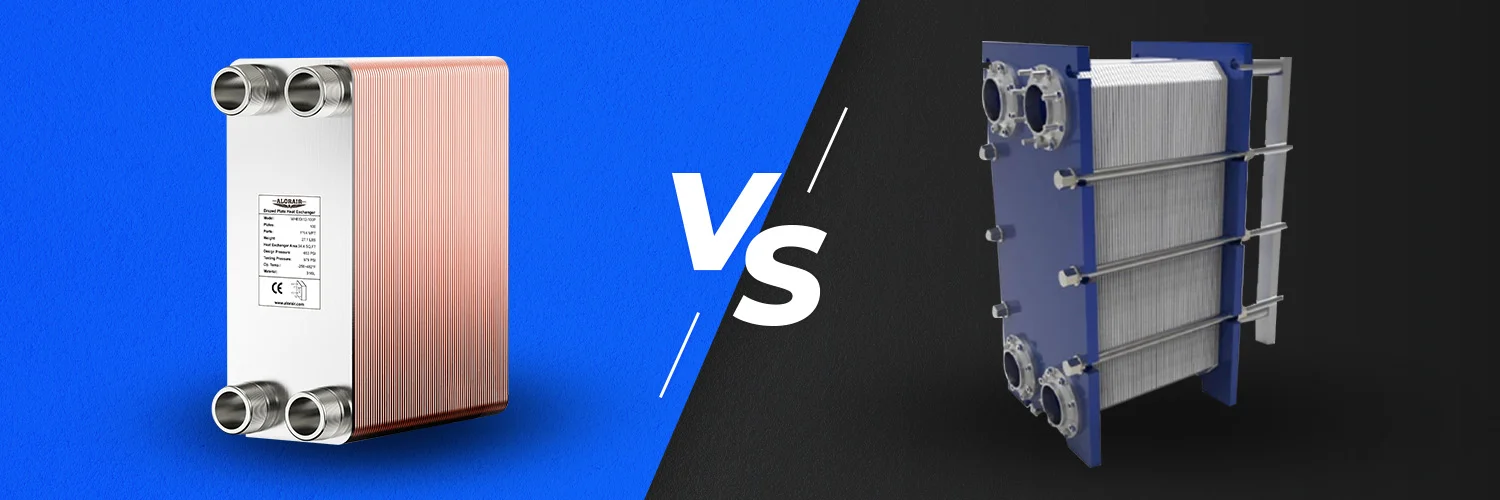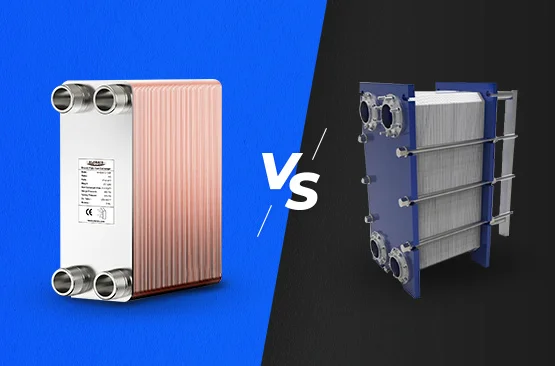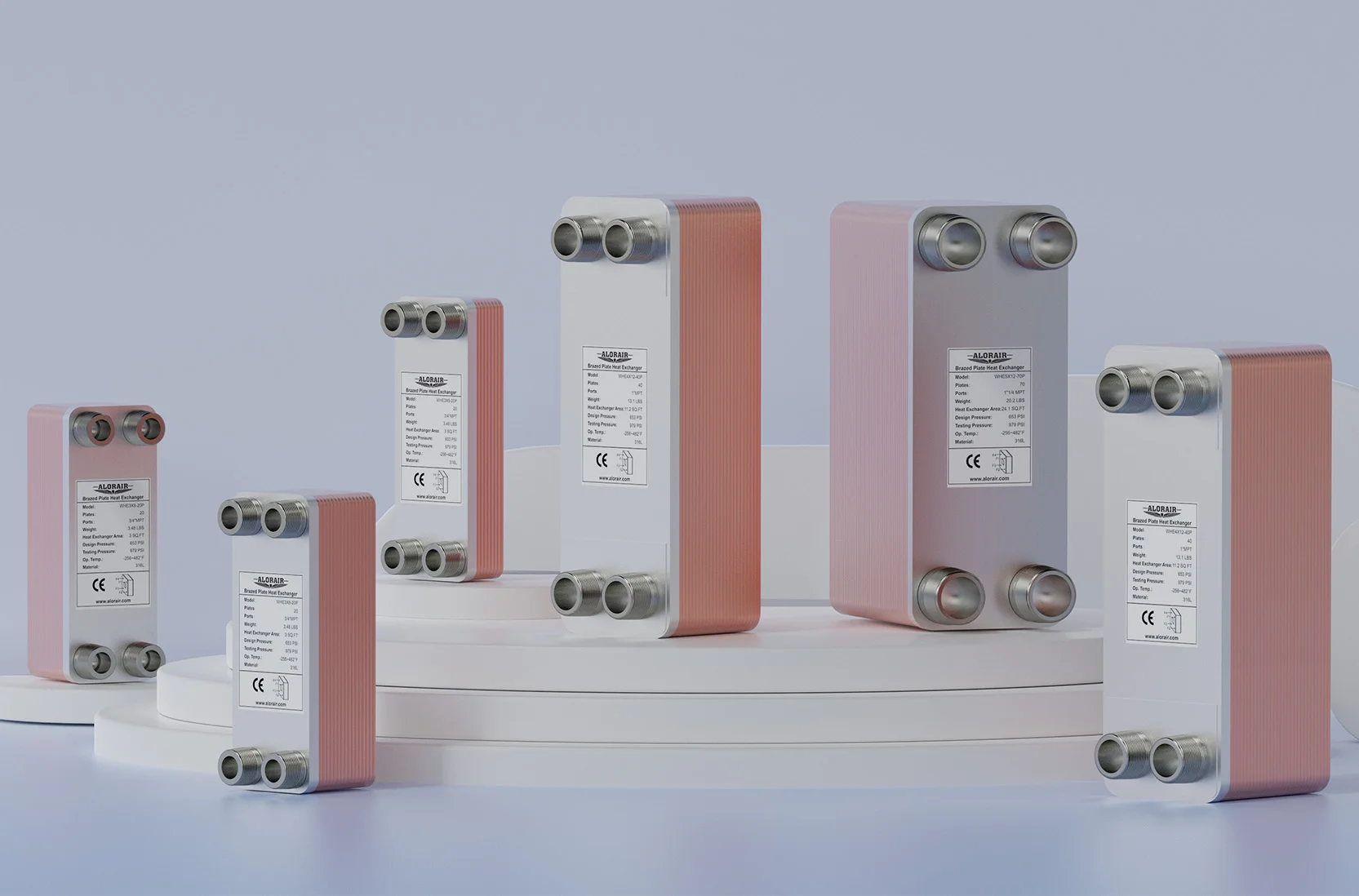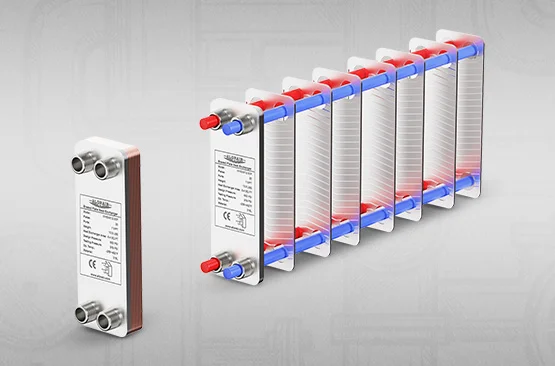Brazed vs. Gasketed Heat Exchangers: What’s the Difference?


- Author: Denrie Perez
- Date Posted:
Efficient thermal management is key to ensuring system performance and reliability.
At the heart of many thermal control systems lies the heat exchanger. While the function remains consistent, the form can vary. Choosing the right type of heat exchanger can have a lasting impact on system performance and operational costs.
While both Brazed Plate Heat Exchangers (BPHEs) and Gasketed Plate Heat Exchangers (GPHEs) offer viable solutions for thermal transfer, their differences in design and performance have significant implications for system efficiency, maintenance requirements, and lifecycle costs.
Importance of Optimizing Thermal Management
Thermal control is fundamental to operational stability, energy efficiency, and system longevity. Without proper heat control, systems run hotter, work harder, and break down faster.
Inadequate thermal management can lead to:
- Reduced component efficiency
- Accelerated wear due to thermal cycling
- Downtime due to overheating or system stress
- Increased energy consumption and operational costs
As system performance expectations grow more demanding, selecting the most efficient, compact, and reliable thermal solution becomes a key design consideration.
Understanding The Role of Heat Exchangers
A heat exchanger facilitates the transfer of thermal energy between two fluid streams without allowing them to mix.
Whether you’re extracting heat from a building or injecting warmth into a system, the exchanger’s efficiency defines how well the whole operation runs. The efficiency of a heat exchanger directly influences the system’s temperature control precision, pressure drop, energy use, and response time.
Brazed Plate vs Gasketed Heat Exchangers
While both brazed and gasketed plate heat exchangers perform the core function of transferring heat between fluid streams, they differ significantly in design, performance, and maintenance characteristics.
Brazed Plate Heat Exchangers (BPHE)
These units are constructed from a series of stainless steel plates that are permanently bonded together using a brazing material, typically copper or nickel. This creates a compact, fully sealed unit with no gaskets, offering high mechanical strength and excellent resistance to pressure and temperature variations.
Due to the thin plate geometry and the high degree of turbulence created by the flow paths, BPHEs are known to deliver increased thermal efficiency. They’re particularly well-suited for clean, closed-loop systems where minimal maintenance and space-saving installation are top priorities.
These qualities make BPHEs the preferred solution in HVAC systems, industrial process cooling, heat pumps, and refrigeration applications where efficiency, reliability, and compactness are essential.
Gasketed Plate Heat Exchangers (GPHE)
In contrast, GPHEs consist of plates that are clamped within a frame and sealed using elastomeric gaskets. This design allows for disassembly, making GPHEs a strong choice for applications where regular cleaning, inspection, or reconfiguration is necessary. This is the case for systems that handle fouling liquids or require sanitary compliance.
However, this flexibility comes at a cost: the gaskets degrade over time, increasing the risk of leaks and requiring periodic maintenance or replacement. GPHEs also tend to be larger and less thermally efficient than BPHEs.
Overall, while GPHEs have their place in systems that demand easy access and flexible design, Brazed Plate Heat Exchangers consistently offer higher performance, better durability, and a more compact unit.
Choosing the Right Heat Exchanger
Choosing between a brazed or gasketed unit involves evaluating your system’s specific thermal and mechanical requirements. Key factors to consider include:
Thermal Performance
At the core of every heat exchanger selection is thermal performance. You’ll need to evaluate the required heat load, temperature ranges, flow rates, and how efficiently the unit can transfer heat between media.
Fluid Compatibility
Factors such as corrosiveness, viscosity, particulate content, and fouling potential are critical to selecting the right heat exchanger. Some designs work best with clean fluids in closed loops, while others are built to handle dirty, abrasive, or chemically aggressive media.
Space Constraints
Some heat exchangers are compact and integrate easily into tight layouts, while others require more room for access, piping, and service. Understanding your installation environment early on can help prevent costly adjustments later.
Operating Pressure and Temperature
Consider the operating conditions your system will face, including pressure drops and potential temperature spikes. Choosing a unit rated for your system’s maximum conditions ensures long-term durability and safe operation.
Serviceability and Maintenance
Some units are fully sealed and designed for long service life with minimal upkeep, while others can be disassembled for cleaning, inspection, or reconfiguration. Consider how accessible the unit needs to be and how often it will require servicing based on your operating environment.
The Advantages of Brazed Plate Technology
Brazed plate heat exchangers have become a go-to solution for modern thermal systems. Their design offers several key advantages over traditional heat exchanger technologies.
Increased Heat Transfer Efficiency
The brazed plate design creates highly turbulent flow across thin, corrugated plates, significantly enhancing heat transfer efficiency. This allows for a high level of thermal performance in a relatively compact unit–a major advantage in space-constrained environments like HVAC systems, refrigeration units, and industrial equipment.
AlorairCoil’s brazed plate heat exchangers are designed with a fishbone corrugated pattern, enhancing turbulence and boosting heat transfer efficiency by 99%.
Superior Mechanical Durability
The brazing process bonds the plates into a single, pressure-resistant unit capable of withstanding high operating pressures and temperatures. With no gaskets or welded joints to weaken over time, BPHEs are highly durable and well-suited for demanding, high-stress environments.
AlorairCoil’s brazed plate heat exchangers are constructed from 316L stainless steel and brazed with copper, delivering maximum performance and durability.
Simplified System Integration
BPHEs are easy to install and can be oriented vertically or horizontally to fit into tight spaces. Their lightweight construction reduces structural load and allows for more flexible system design, particularly in mobile or modular applications.
Reduced Maintenance Requirements
With no gaskets to replace and minimal maintenance required in clean-fluid systems, downtime is significantly reduced. This translates to lower operational costs and a more reliable system overall.
Conclusion
The decision between brazed and gasketed plate technologies hinges on understanding your system’s thermal requirements, fluid conditions, space limitations, and long-term maintenance needs.
Explore how AlorairCoil’s brazed plate heat exchangers can optimize your heating and cooling system.
Other Posts You Might Like
10 Benefits of Brazed Plate Heat Exchangers Over Traditional Coil Systems
When it comes to efficient heat transfer, not all systems are created equal. While traditional coil heat exchangers (such as […]
The Science Behind Heat Transfer in Brazed Plate Heat Exchangers
In industrial and commercial applications, the need for high-efficiency heat exchange systems is ever-growing. Brazed plate heat exchangers have become […]
Brazed vs. Gasketed Heat Exchangers: What’s the Difference?
Efficient thermal management is key to ensuring system performance and reliability. At the heart of many thermal control systems lies […]


